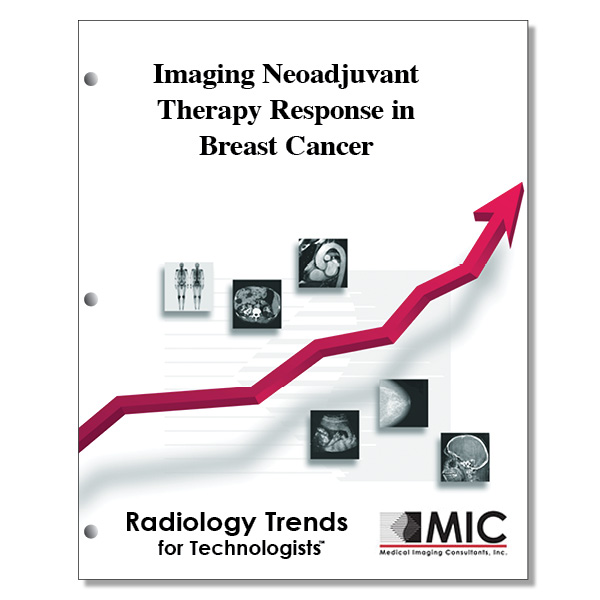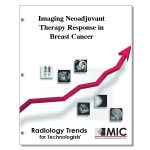

Imaging Neoadjuvant Therapy Response in Breast Cancer
The advantages and limitations of current assessment methods for neoadjuvant therapy response for patients with primary breast cancer are presented and new functional and molecular imaging approaches are reviewed.
Course ID: Q00573 Category: Radiology Trends for Technologists Modalities: Mammography, MRI, Nuclear Medicine, PET, Radiation Therapy2.5 |
Satisfaction Guarantee |
$29.00
- Targeted CE
- Outline
- Objectives
Targeted CE per ARRT’s Discipline, Category, and Subcategory classification:
[Note: Discipline-specific Targeted CE credits may be less than the total Category A credits approved for this course.]
Breast Sonography: 2.00
Patient Care: 0.50
Patient Interactions and Management: 0.50
Image Production: 0.50
Evaluation and Selection of Representative Images: 0.50
Procedures: 1.00
Anatomy and Physiology: 0.25
Pathology: 0.25
Breast Interventions: 0.50
Mammography: 2.00
Patient Care: 1.00
Patient Interactions and Management: 1.00
Procedures: 1.00
Anatomy, Physiology, and Pathology: 0.50
Mammographic Positioning, Special Needs, and Imaging Procedures: 0.50
Magnetic Resonance Imaging: 1.25
Patient Care: 0.25
Patient Interactions and Management: 0.25
Procedures: 1.00
Body: 1.00
Nuclear Medicine Technology: 1.25
Patient Care: 0.25
Patient Interactions and Management: 0.25
Procedures: 1.00
Endocrine and Oncology Procedures: 1.00
Registered Radiologist Assistant: 2.00
Procedures: 2.00
Thoracic Section: 2.00
Sonography: 1.25
Patient Care: 0.25
Patient Interactions and Management: 0.25
Procedures: 1.00
Superficial Structures and Other Sonographic Procedures: 1.00
Radiation Therapy: 1.50
Patient Care: 1.00
Patient and Medical Record Management: 1.00
Procedures: 0.50
Treatment Sites and Tumors: 0.50
Outline
- Introduction
- Current Methods
- Mammography and US
- MR Imaging
- Functional and Molecular Imaging
- Pharmacokinetic Analysis of DCE Perfusion MR Imaging
- Diffusion-weighted MR Imaging
- MR Spectroscopy
- FDG PET Imaging
- FLT PET Imaging
- Imaging Amino Acid Metabolism
- 11C-Choline PET
- PET Imaging of Tumor Blood Flow and Metabolism
- Challenges and Future Directions
- Standardized Reporting and Response Evaluation Criteria
- Combined Multimodality Imaging Approaches
- Conclusion
Objectives
Upon completion of this course, students will:
- know the local-regional therapy and adjuvant systemic therapy options for patients with breast cancer
- know which patients can be effectively treated in the neoadjuvant setting
- be familiar with the benefits and potential benefits of neoadjuvant therapy
- know what types of breast cancer are part of a “triple-negative” breast cancer diagnosis
- be familiar with the abbreviations used throughout this article
- understand why neoadjuvant therapy is not frequently used for patients with well-differentiated estrogen receptor-positive breast disease
- know the current clinical practice guidelines for how best to assess tumor response to adjuvant therapy
- know what is typically performed prior to each chemotherapy cycle or monthly if neoadjuvant endocrine therapy is used
- recognize the challenges with physical examination in patients with locally advanced breast cancer after neoadjuvant hormonal or chemotherapy
- know why whole-breast ultrasound is not generally recommended for patients who are unable to undergo MR imaging
- be familiar with the goals of pretherapy imaging
- know the NCCN guidelines’ recommendation after the completion of therapy
- be familiar with the facts about mammography as stated in the article
- be familiar with the facts about ultrasound as stated in the article
- know why MR imaging is not currently reliable enough to allow patients to avoid surgical resection after complete imaging response
- identify the MR images used when measuring functional tumor volume using the signal enhancement ratio method
- understand the potential clinical impacts of over-estimation and under-estimation of residual tumor size after surgical excision
- know the factors that have been shown to affect the diagnostic accuracy of MR imaging for therapy response assessment
- know the main limitations which cause MR imaging to not be universally utilized in preoperative breast assessment
- specify a major drawback of conventional imaging and physical examination in therapy response assessment
- know the essential factors for successful clinical adoption of the functional and molecular imaging techniques discussed in the article
- understand the pharmacokinetic action of contrast material within malignant lesions for DCE perfusion MR imaging
- know the DCE perfusion MR kinetic parameter(s) that have been demonstrated to be associated with both treatment response and nonresponse
- identify the term used in diffusion-weighted MR imaging to quantify the random Brownian motion of water molecules within tissue and inversely correlates with tumor cellularity
- know what molecule’s resonance peak is elevated in malignant lesions when compared with benign and normal breast tissue in MR spectroscopy imaging
- know the conditions for which breast FDG PET imaging appears to aid
- be aware of the potential methodologic and biologic factors which contribute to FDG PET sensitivity and specificity for evaluating response to neoadjuvant chemotherapy in patients with breast cancer
- know some of the basic facts of FLT PET imaging and uptake
- understand why FLT PET/CT currently has limited clinical utility for staging
- be familiar with what the uptake of radiolabeled amino acid 11C-methionine is associated, and what this association can indicate
- be familiar with some of the basic facts about breast cancer imaging with 11C-choline
- be aware of how PET imaging agents can be combined to better predict pathologic response to neoadjuvant chemotherapy for patients newly diagnosed with locally advanced breast cancer
- know the PET imaging technique that found persistent or elevated tumor blood flow to be associated with lower overall survival
- know some reasons why the RECIST 1.1 criteria for breast imaging may be problematic for use
- be familiar with the facts about the PERCIST criteria for evaluating tumor response to therapy with FDG PET imaging
